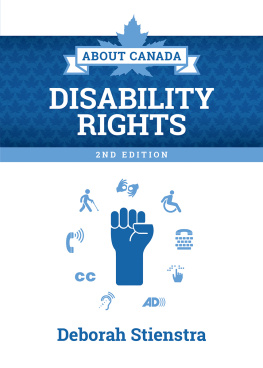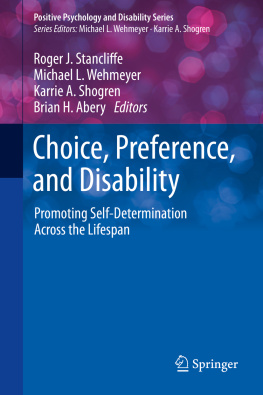
Disability Rights

Disability Rights
2 nd edition
Deborah Stienstra

Halifax & Winnipeg
Copyright 2020 Deborah Stienstra
All rights reserved. No part of this book may be reproduced or transmitted in any form by any means without permission in writing from the publisher, except by a reviewer, who may quote brief passages in a review.
Editing: Jessica Antony
Design: John van der Woude
eBook: tikaebooks.com
Printed and bound in Canada
Published in Canada by Fernwood Publishing
Oceanvista Lane, Black Point, Nova Scotia, b0j 1b0
and Broadway Avenue, Winnipeg, mb r3g 0x3
www.fernwoodpublishing.ca
Fernwood Publishing Company Limited gratefully acknowledges the financial support of the Government of Canada through the Canada Book Fund and the Canada Council for the Arts, the Nova Scotia Department of Communities, Culture and Heritage, the Manitoba Department of Culture, Heritage and Tourism under the Manitoba Publishers Marketing Assistance Program and the Province of Manitoba, through the Book Publishing Tax Credit, for our publishing program.

ISBN: 9781773632551
Library and Archives Canada Cataloguing in Publication data has been applied for.
CONTENTS
To those
including Patrick Kellerman, Henry Enns, Catherine Frazee, Heidi Janz, Jim Derksen, Bonnie Brayton, Steve Estey and many others who have taught and continue to teach me how to live well, including with disabilities.
ACKNOWLEDGEMENTS
F or their assistance with the second edition I would like to thank Lara Haines-Love, Shreya Jadhav, Benedicta Hughes, Victoria Watt and the Live Work Well Research Centre at the University of Guelph. Greg Corey is a consistent source of support and love for me, for which I am deeply grateful. My children, Becca and Cailum, and my large extended family and friends keep reminding me how important telling these stories are and I thank them for their support of my work and life.
1
What Are Disability Rights?
I am a person with a disability and living on social assistance. I find that after I pay my bills, like rent and phone and cable, I am left with $250 a month for food, household things like clothing, coffee, and anything else I might need or want to do. That works out to about $7 a day for everything. The cost of food goes up and my pension cheques stay the same. Other costs go up, like cable or phone, and my disability pension stays the same. I shop for clothes at thrift shops so I dont buy anything new. I have my clothes on today from thrift shops. I like going to Tim [Horton]s sometimes for lunch or for coffee, but I often dont have any money left to do that. It costs a lot to buy healthy food. I need help to pick the right food and I need more money to buy things that will keep me healthy. I would like to have more to live on.
I would like the public to be aware that living on social assistance puts the person, that is me and many of my friends and most of our People First members, in poverty. And then when we try to work, they cut back on the assistance. And how we can buy clothes for work and pay for the transportation to get there? It is like they try to keep people with intellectual disabilities poor and dependent. We need jobs that will help us to be helpful in our communities and that will help us to live with some respect. We care that people with intellectual disabilities are still placed in institutions. Imagine how poor they are. No jobs, no going to Tim [Horton]s with friends, no choices in what to eat. No way to get to be a member of groups like People First. No way to live like the rest of us here, that is in poverty.
Im learning that we have rights like all Canadians. While Im not sure is if having rights will help us come out of poverty.
Calvin Wood, President of People First Nova Scotia
Earlier the same year that Calvin Wood wondered if having disability rights would get people with disabilities out of poverty, on March 11, 2010, just before the start of the Paralympics in Vancouver, the Canadian government announced that it ratified the United Nations Convention on the Rights of Persons with Disabilities ( uncrpd ), the international agreement on disability rights. The Convention includes basic principles, such as: respect for inherent dignity; individual autonomy, including the freedom to make ones own choices; non-discrimination; full and effective participation and inclusion in society; respect for difference and acceptance of persons with disabilities as part of human diversity; equality of opportunity; accessibility; equality between men and women; and respect for the evolving capacities of children with disabilities. These international rights echo the disability rights embedded in Section 15 of the Canadian Charter of Rights and Freedoms, which came into force on April 17, 1985: Every individual is equal before and under the law and has the right to the equal protection and equal benefit of the law without discrimination and, in particular, without discrimination based on mental or physical disability.
Why does Calvin Wood wonder whether having these rights will help him get out of poverty? One of the major reasons that Calvin lives in poverty is because many in Canadian society think that having an impairment or condition means that he and others are not able to work at a regular job, that they shouldnt have children and that they are different, often in ways that are limiting, pitiful or devaluing. The disability is actually created by attitudes and assumptions about difference and impairment, rather than the impairment itself.
This approach to disability, which is often called socially constructed or the social model of disability, recognizes that humanity is made up of a wide range of bodies. Through the meaning we give to these differences we create societies, schools, workplaces and programs that can include or exclude people. The challenge of disability rights is to recognize the ways in which we discriminate against or exclude people with these impairments and conditions, and work to change so that there can be full participation, inclusion and access for all people in Canada.
The social model of disability was created as a response to the dominant perspective on disability, often called the medical model of disability. The medical model says people are disabled because they have an impairment or disease. The goal of the medical model is to identify what makes individuals different from what is considered normal, whether that is a variation in their body or difference in how their bodies or minds function. Once the abnormality has been identified and labelled, the work is to treat, fix or rehabilitate the individual to maximize their functioning. Interventions most often involve medical or health professionals. Historically, this model has also been linked to eugenics, which distinguished the fit from the unfit.
Who Are People with Disabilities?
Disabled people are us people who work, play, go to school, live in families, raise children, are gay and straight, eat, cook, care about the environment, surf the internet. No matter where you look, or who you speak to in Canadian society, youll find a person with disabilities or someone with disabilities in their lives.













